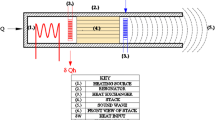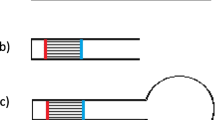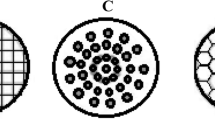Abstract
Experimental investigations are performed on a half-wavelength standing wave type thermoacoustically driven thermoacoustic refrigerator also known as TADTAR. Present TADTAR device conceived to be a quarter wavelength standing wave type thermoacoustic engine (TAE) coupled to a quarter wavelength standing wave thermoacoustic refrigerator (TAR). A TAE generates acoustic work using heat, and this produced acoustic work is directly fed to TAR where a useful cooling effect is developed. The study here aims to project the enhancement in the performance of a TADTAR system by using better geometric choices and operating conditions. In the present work, by keeping the engine part unaltered, parametric variations on the refrigerator side are performed. Two geometric parameters namely resonator length and TAR stack position and one operating parameter, working gas, have been varied at three distinct choices. The performance of TADTAR is examined for three output parameters of TADTAR namely frequency of oscillations, pressure amplitude, and temperature difference across TAR stack. The present study should be useful for assisting select these parameters for starting the designing of a TADTAR. It also helps in concluding in a more generalized way the dependence of the above-said output of TADTAR on the varying parameters. This paper shows that longer resonator and He-Ar mixture as working gas among the choices is better for a TADTAR system for achieving better performance. It also highlights the potential existence of a unique position for a stack length for a TADTAR to attain maximum performance in terms of the temperature difference across the TAR stack. The present paper reports the maximum temperature difference of 16.3 K across the TAR stack.













Similar content being viewed by others
Abbreviations
- \( k \) :
-
Thermal conductivity (W/m-K)
- \( C_{p} \) :
-
Specific heat at constant pressure (J/kg-K)
- \( L \) :
-
Length of resonator (m)
- \( f \) :
-
Frequency of oscillations (Hz)
- \( a \) :
-
Acoustic velocity of the gas (m/s)
- \( \delta \) :
-
Penetration depth (m)
- \( \rho \) :
-
Density (kg/m3)
- \( \omega \) :
-
Angular frequency of oscillations (rad/s)
- \( \lambda \) :
-
Wavelength (m)
- k :
-
Thermal
- TADTAR:
-
Thermoacoustic engine driven thermoacoustic refrigerator
- TAE:
-
Thermoacoustic engine
- TAR:
-
Thermoacoustic refrigerator
- PAN:
-
Pressure antinode
- PN:
-
Pressure node
- VAN:
-
Velocity antinode
- VN:
-
Velocity node
References
Rott N 1969 Damped and thermally driven acoustic oscillations in wide and narrow tubes. J. Appl. Math. Phys. 20: 230–243
Rott N 1975 Thermally driven acoustic oscillations, part III: Second-order heat flux. J. Appl. Math. Phys. 26: 43–49
Rott N 1980 Thermoacoustics. Adv. Appl. Mech. 20: 135–175
Rayleigh J W S 1886 The theory of sound. 2nd edition Vol. 2 Sec. 322. (Dover, New York, 1945)
Swift G W 1988 Thermoacoustic engines. J. Acoust. Soc. Am. 84: 1145–1180
Tijani M E H, Zeegers J C H and De Waele A T A M 2002 Design of thermoacoustic refrigerators. Cryogenics 42: 49–57
Wollan J J, Swift G W, Backhaus S and Gardner D L 2002 Development of a thermoacoustic natural gas liquefier. AIChE New Orleans Meeting. 1–8
Poese M E, Smith R W M, Garrett S L, Van Gerwen R and Gosselin P 2004 Thermoacoustic refrigeration for ice cream sales. Web
Swift G W 1988 A liquid-metal magnetohydrodynamic acoustic transducer. J. Acoust. Soc. Am., 83: 350–361
Ovando G, Huelsz G, Ramos E and Cuevas S 2005 Effect of a magnetic field on the linear stability of a thermoacoustic oscillation. J. Non-Equil. Thermodyn. 30: 1–27
Yu Z, Jaworski A J and Backhaus S 2012 Traveling-wave thermoacoustic electricity generator using an ultra-compliant alternator for utilization of low-grade thermal energy. Appl. Energy 99: 135–145
Abdoulla-Latiwish K O A, Mao X and Jaworski A J 2017 Thermoacoustic micro-electricity generator for rural dwellings in developing countries driven by waste heat from cooking activities. Energy 134: 1107-1120
Jin T, Chen G B and Shen Y 2001 A thermoacoustically driven pulse tube refrigerator capable of working below 120 K. Cryogenics 41: 595–601
Tang K, Chen G, Jin T, Kong B, Bao R, Qui L and Gan Z 2004 92 K thermoacoustically driven pulse tube refrigerator. Chinese Sci. Bull. 49: 1541–1542
Geller D A, Spoor P S and Swift G W 2001 Separation of gas mixtures by thermoacoustic waves. Web
Wheatley J C, Swift G W, Migliori A and Hofler T J 1989 Heat driven acoustic cooling engine having no moving parts. US Patent No. 4858441
Adeff J A and Hofler T J 2000 Design and construction of a solar-powered, thermoacoustically driven thermoacoustic refrigerator. J. Acoust. Soc. Am., 107: 37–42
Luo E, Dai W, Zhang Y and Ling H 2006 Thermoacoustically driven refrigerator with double thermoacoustic Stirling cycles. Appl. Phys. Lett. 88: 074102
Kang H, Jiang F, Zheng H and Jaworski A J 2013 Thermoacoustic traveling wave cooler driven by a cascade thermoacoustic engine. Appl. Therm. Eng. 59: 223–231
Tasnim S H and Fraser R A 2010 Thermal field measurements of a thermoacoustically driven thermoacoustic refrigerator. J. Therm. Sci. Eng. Appl. 2: 021010
Hariharan N M, Sivashanmugam P and Kashturirengan S 2013 Experimental investigation of a thermoacoustic refrigerator driven by a standing wave twin thermoacoustic prime mover. Int. J. Ref. 36: 2420–2425
Desai A B, Desai K P, Naik H B and Atrey M D 2016 Design and analysis of standing wave quarter wavelength thermoacoustic engine. Indian J. Cryog. 41: 69–74
Desai A B, Desai K P, Naik H B and Atrey M D 2017 Optimization of thermoacoustic engine driven thermoacoustic refrigerator using response surface methodology. IOP Conf. Ser. Mater. Sci. Eng. 171: 012132
Alcock A C, Tartibu L K and Jen T C 2018 Experimental investigation of an adjustable thermoacoustically-driven thermoacoustic refrigerator. Int. J. Ref. 94: 71–86
Saechan P and Jaworski A J 2018 Thermoacoustic cooler to meet medical storage needs of rural communities in developing countries. Therm. Sci. Eng. Prog. 7: 164–175
Khripach N A, Lezhnev L Y, Ivanov D A, Papkin B A and Korotkov V S 2018 Computational analysis of the exhaust gas cooler of an automobile engine. Int. J. Pure Appl. Math. 119: 2627–2631
Balonji S, Alcock A C, Tartibu L K and Jen T C 2019 Performance alteration of standing-wave thermoacoustically-driven engine through resonator length adjustment. Procedia Manuf. 35: 1350–1355
Tijani M E H, Zeegers J C H and De Waele A T A M 2002 Prandtl number and thermoacoustic refrigerators. J. Acoust. Soc. Am. 112: 134–143
Setiawan I, Nohtomi N and Katsuta M 2015 Critical temperature differences of a standing wave thermoacoustic prime mover with various helium-based binary mixture working gases. J. Phys. Conf. Ser. 622: 012010
Swift G W 1995 Thermoacoustic engines and refrigerators. Phys. Today 48: 22–28
Acknowledgements
Authors are thankful to the Board of Research in Nuclear Science (BRNS), Government of India (No. 2013/34/17/BRNS) for funding the research project under which the present work is carried out.
Author information
Authors and Affiliations
Corresponding author
Rights and permissions
About this article
Cite this article
DESAI, A.B., DESAI, K.P., NAIK, H.B. et al. Experimental study and analysis of a thermoacoustically driven thermoacoustic refrigerator. Sādhanā 45, 213 (2020). https://doi.org/10.1007/s12046-020-01452-9
Received:
Revised:
Accepted:
Published:
DOI: https://doi.org/10.1007/s12046-020-01452-9




